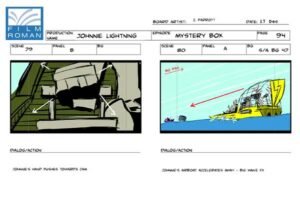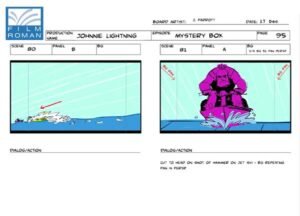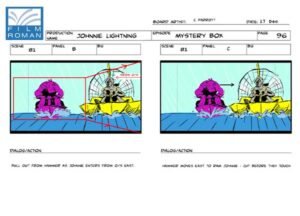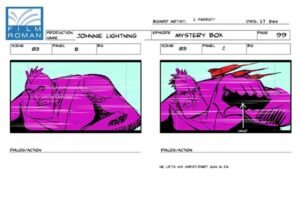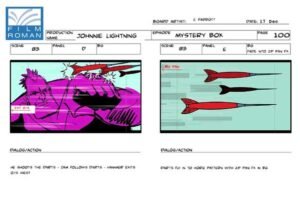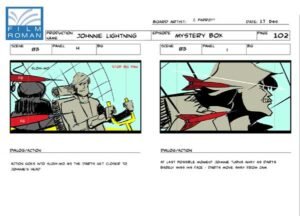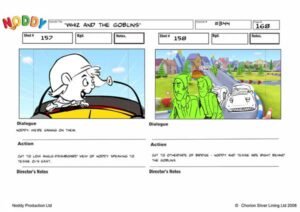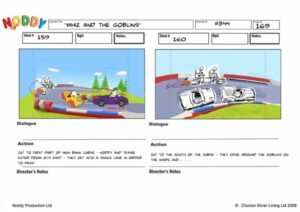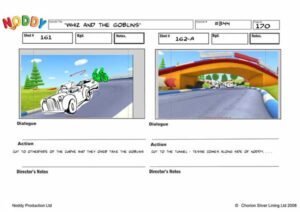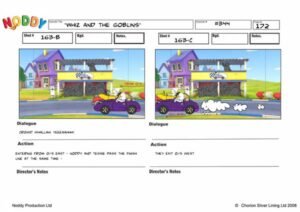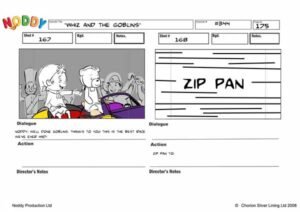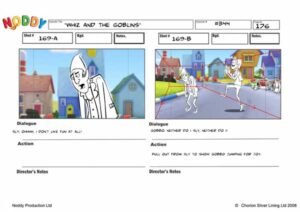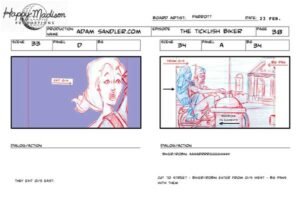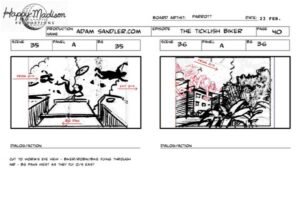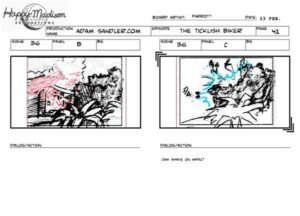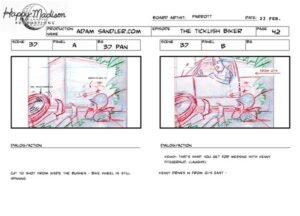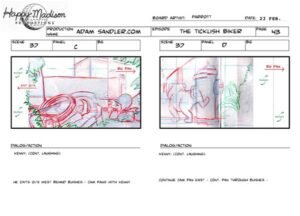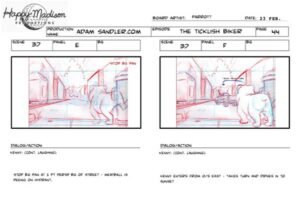Storyboards & Animatics
storyboard work
Why Storyboard?
To save time, many animation and film studios go straight into the animatic and with software such as Toon Boom Storyboard Pro, it’s an option. But from experience, if the goal is to save time, the best way to insure the board artist and the director are on the same page (pun intended), it’s wise to start with at least a thumbnail pass of the boards.
Traditional Animation Boards
I started boarding when they were printed out and updated by cutting out/inserting Post-It notes with Scotch Tape (Sellotape). By the time the board was ‘locked’, the stack of pages could be fairly thick. The various copies to the crew, director, producer and network were made by putting them through a copier. Though you’d never put them through an automatic feeder – did it once and it destroyed days of work. Luckily, those issues are a thing of the past not that it’s all digital.
Storyboard Stages
Depending on the studio, customs, and workflows, the usual stages of boarding are:
- Thumbnails
- Roughs
- Cleans (These could be done by a trainee).
Storyboard Style
The boards’ style can be “loose” where maximising poses and emotion is the emphasis, or they can be “tight” where the characters need to be “on-model”. These boards have a dual use of acting like Lay Out for the animators and are the most time consuming.
JOHNNIE LIGHTNING - Film Roman
This project was one of my earlier boards but it was a lot of fun because of all the action scenes. I got to create the animatic based off the boards and really got into the quick paced timing, and dynamic camera angles. Some of the footage is featured in the Animatics video below if you’d like to see the results! Here are a few of the boards from the end of Act 2, breaking into 3. Click on the Board Pages Below to Start the Gallery View
Noddy in Toyland - Brown Bag Films
This was one of the first board assignments received when coming to live in Ireland. One of the reasons why I liked boarding this was because it was a 3D series. It forced the board artist to consider a limited amount of camera angles. Unlike 2D, boarding for 3D requires the artist to consider the costs of rendering shots too many camera angles. The reduced amount of options focuses one to nail the story essentials. It was a challenge but mostly, I liked drawing the bad guys, Sly & Gobbo- they were actually quite entertaining for preschool baddies. Click on the Board Pages Below to Start the Gallery View
THE TICKLISH BIKER - Adam Sandler/Happy Madison
This was one of the last boards I did using the trusty ol’ pencil. I really enjoyed working on this for a few reasons, but the foremost was the chance to work on an unadulterated, adult comedy. Adam’s known for his ‘salty’ language and even ‘saltier’ subject matter. He was very involved in the project from start to finish but was very keen to get the boards correct. The boards process was made a bit easier because the audio play was already done and locked, the boards were constrained to follow it. There's a little Easter Egg in there: the bulldog at the end peeing on the hydrant was his dog, Meatball. Click on the Board Pages Below to Start the Gallery View
animatics
If you’re not familiar with animatics, or unsure exactly what they do, here’s a definition: Animatics are basically animated storyboard panels extended on a timeline synched with audio to previsualise a finished project. They’re not just for animation, some live action directors use them and also visual effects (VFX) heavy productions.
Animatics can be made many different ways and they’re fairly quick and simple to put together, edit, and re-edit until it’s approved. The reason why animatics are SO IMPORTANT in the animation process is because they’re reasonably easy/quick to make. Finished animation, whether it’s 2D, 3D, or stop-motion is very, very expensive – thousands of euros per minute. And because of these hefty costs, the story editing comes first, (juxtaposed to live action where the editing comes after the footage is made). You want to know exactly what you’re going to produce before spending any precious resources.
Depending on the needs, animatics come in different styles and production value. Some are basic stick figures moved around, while other high-end productions will do Previs in compositing software like Adobe After Effects or a 3D animation in Blender.

